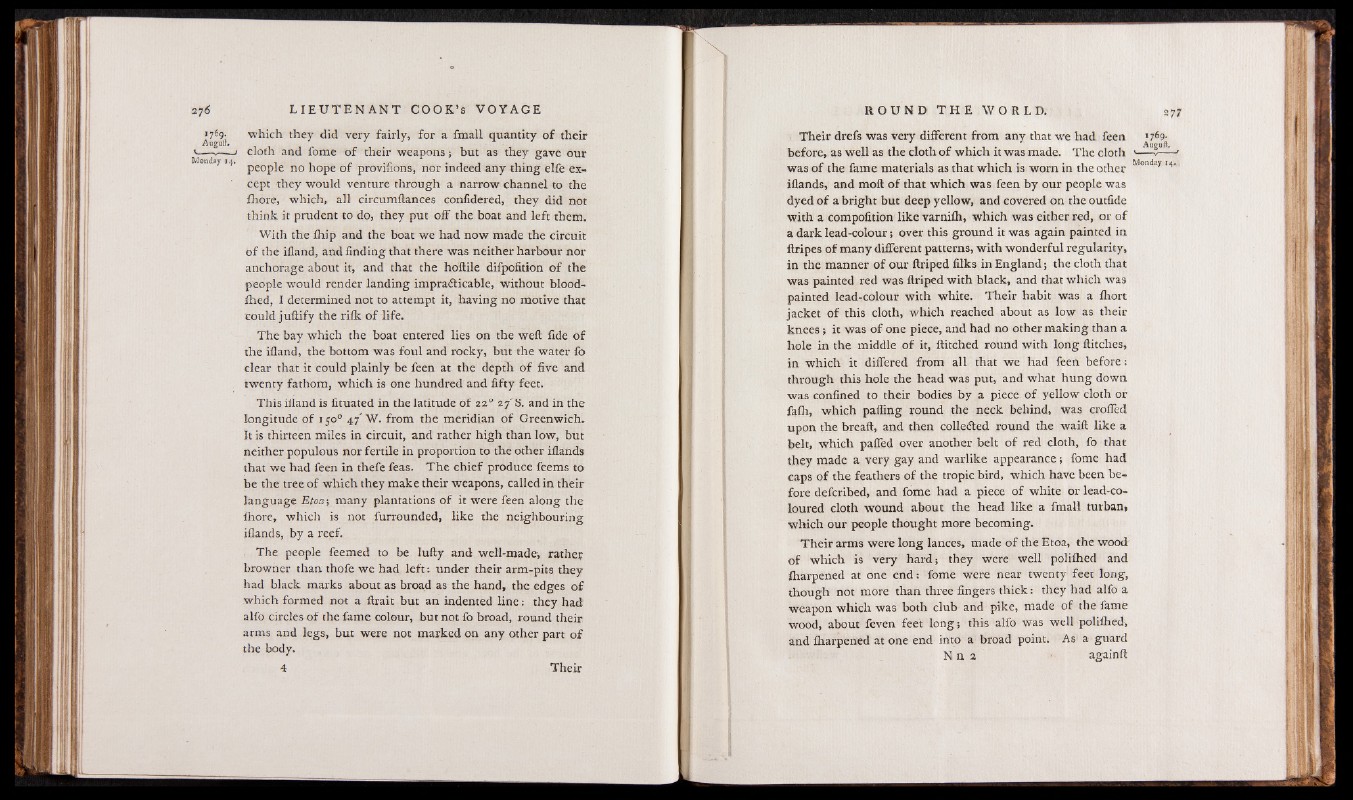
which they did very fairly, for a fmall quantity of their
cloth and fome of their weapons | but as they gave our
people no hope of provifions, nor indeed any thing elfe except
they would venture through a narrow channel to the
fhore, which, all circumftances confidered, they did not
think it prudent to do, they put off the boat and left them.
With the fhip and the boat we had now made the circuit
of the ifland, and finding that there was neither harbour nor
anchorage about it, and that the hoftile difpofition of the
people would render landing impracticable, without blood-
fhed, I determined not to attempt it, having no motive that
could juftify the rilk of life.
The bay which the boat entered lies on the weft fide of
the ifland, the bottom was foul and rocky, but the water fo
clear that it could plainly be feen at the depth of five and
twenty fathom, which is one hundred and fifty feet.
This ifland is fituated in the latitude of 220 27' S. and in the
longitude of 1500 47' W. from the meridian of Greenwich.
It is thirteen miles in circuit, and rather high than low, but
neither populous nor fertile in proportion to the other iflands
that we had feen in thefe feas. The chief produce feems to
be the tree of which they make their weapons, called in their
language Etocr, many plantations of it were feen along the
Ihore, which is not furreunded, like the neighbouring
iflands, by a reef.
The people feemed to be lufty and well-made, rather
browner than thofe we had left: under their arm-pits they
had black marks about as broad as the hand, the edges of
which formed not a ftrait but an indented line: they had
alfo circles of the fame colour, but not fo broad, round their
arms and legs, but were not marked on any other part of
the body.
Their drefs was very different from any that we had feen '769-
before, as well as the cloth of which it was made. The cloth >— ^r— <
was o f the fame materials as that which is worn in the other Monday M'
iflands, and moft of that which was feen by our people was
dyed o f a bright but deep yellow, and covered on the outfide
with a compofition like varnifh, which was either red, or of
a dark lead-colour; over this ground it was again painted in
ftripes o f many different patterns, with wonderful regularity,
in the manner of our ftriped filks in England; the cloth that
was painted red was ftriped with black, and that which was
painted lead-colour with white. Their habit was a Ihort
jacket of this cloth, which reached about as low as their
knees; it was of one piece, and had no other making than a
hole in the middle of it, Hitched round with long flitches,
in which it differed from all that we had feen before:
through this hole the head was put, and what hung down
was confined to their bodies by a piece of yellow cloth or
fafli, which palling round the neck behind, was croffed
upon the breaft, and then collected round the waift like a
belt, which paffed over another belt of red cloth, fo that
they made a very gay and warlike appearance; fome had
caps of the feathers of the tropic bird, which have been before
defcribed, and fome had a piece of white or lead-coloured
cloth wound about the head like a fmall turban,
which our people thought more becoming.
Their arms were long lances, made of the Etoa, the wood
of which is very hard; they were well polifhed and
fharpened at one end: fome were near twenty feet long,
though not more than three fingers thick: they had alfo a
weapon which was both club and pike, made of the fame
wood, about feven feet long; this alfo was well polilhed,
and fharpened at one end into a broad point. As a guard
N n 2 againft